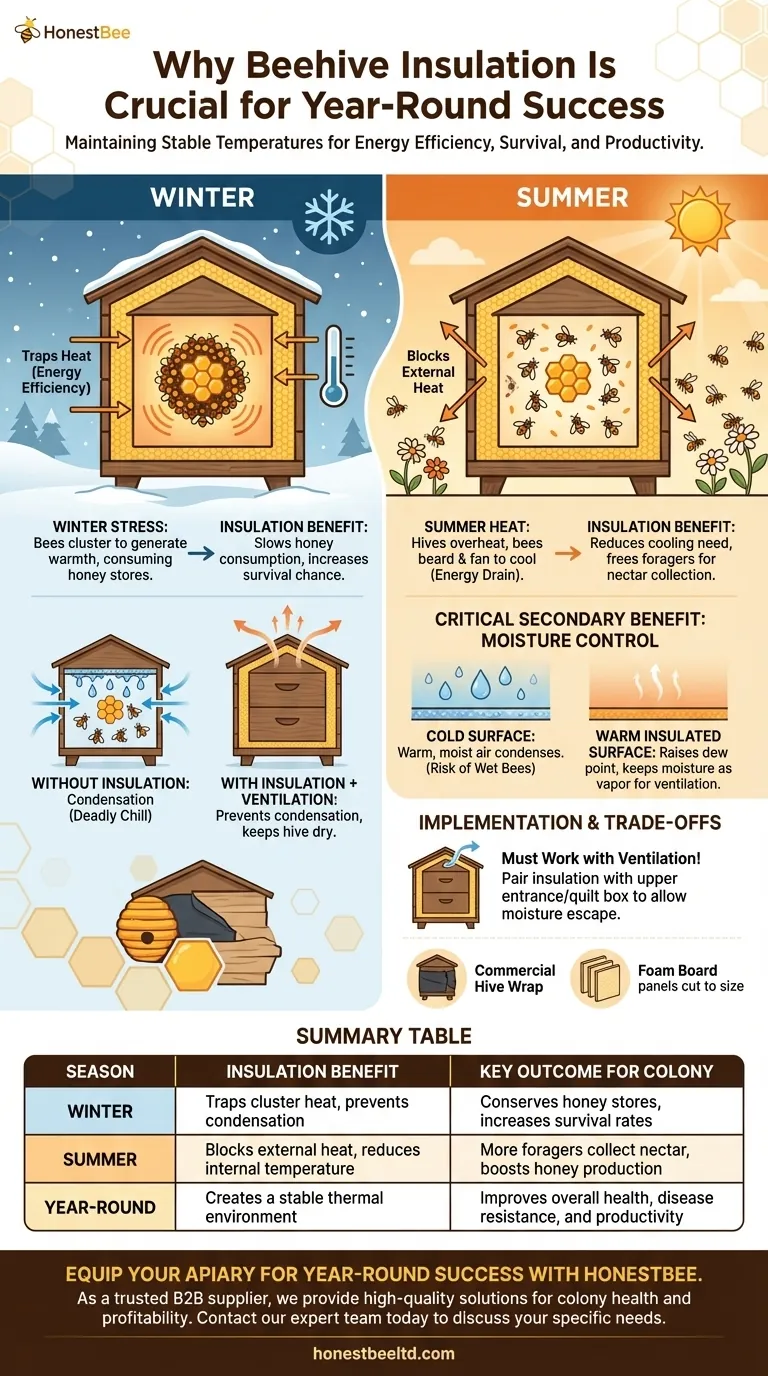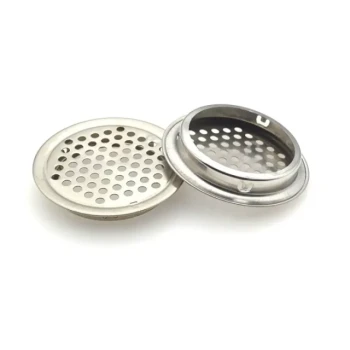The fundamental purpose of beehive insulation is to help the colony maintain a stable internal temperature, regardless of the season. In winter, it traps the heat generated by the bees, and in summer, it blocks external heat. This drastically reduces the amount of energy the bees must expend on temperature regulation.
The core benefit of insulation is energy efficiency. By creating a thermally stable home, you allow the colony to redirect its energy from simple survival—heating or cooling—towards vital activities like raising brood, fighting disease, and producing honey.

The Primary Role of Insulation: Energy Management
A beehive is a living organism that must constantly work to maintain its environment. Insulation reduces the workload required, freeing up resources for the colony to thrive.
Reducing Winter Stress
During winter, bees form a tight cluster to generate and conserve warmth. The colony's survival depends on having enough honey stores to fuel this effort.
Insulation acts like a thermal blanket, trapping the heat produced by the cluster. This minimizes heat loss to the cold outside air.
As a result, the bees consume their honey stores more slowly, increasing their chances of surviving until spring and emerging with more energy for the first nectar flows.
Mitigating Summer Heat
In extreme summer heat, a hive can easily overheat. To combat this, bees will engage in "bearding" on the outside of the hive and fanning their wings to circulate air.
This cooling effort comes at a cost, pulling thousands of forager bees away from their primary task of collecting nectar and pollen.
Insulation provides a crucial barrier against the sun's heat. By keeping the hive's interior cooler, it reduces the need for cooling behaviors and allows more bees to focus on productive foraging.
A Critical Secondary Benefit: Moisture Control
While temperature is a primary concern, managing moisture is equally critical for a healthy colony, especially during winter.
The Dangers of Condensation
Bees release warm, moist air through respiration. In a cold, uninsulated hive, this humid air rises and hits the cold inner cover, where it condenses into water droplets.
This cold water can then drip back down onto the bee cluster, chilling and killing the bees. A wet colony is often a dead colony.
How Insulation Keeps the Hive Dry
By insulating the hive, you keep the interior surfaces warmer. This raises the dew point, preventing water vapor from condensing directly above the bees.
Instead, the moisture can remain as vapor and be properly removed from the hive through ventilation, ensuring the bees stay warm and, more importantly, dry.
Understanding the Trade-offs
Insulation is a powerful tool, but it must be implemented correctly to be effective. It is not a cure-all for a weak or poorly managed colony.
Insulation Must Work with Ventilation
The most common mistake is to insulate a hive without ensuring adequate ventilation. Sealing a hive too tightly will trap the moist air the bees produce.
The goal is to create a warm, dry environment, not a sealed, damp one. Insulation should always be paired with a small upper entrance or ventilated quilt box to allow humid air to escape.
Materials and Methods
Commercial hive wraps are a common and effective solution. They are typically dark-colored to absorb solar radiation during the day and are designed to wrap the hive bodies while leaving entrances and ventilation points clear.
Simple foam board cut to size and placed around the hive bodies can also be highly effective. The key is to reduce heat exchange through the large surface area of the hive walls.
Making the Right Choice for Your Colony
Ultimately, using insulation is about reducing stress on your bees, enabling them to be more resilient and productive throughout the year.
- If your primary focus is winter survival: Insulate to help your bees conserve their precious honey stores and, most critically, to prevent deadly condensation from forming inside the hive.
- If your primary focus is summer productivity: Insulate to reduce heat stress, which keeps more forager bees out in the field collecting nectar instead of inside cooling the hive.
- If your primary focus is overall colony health: Use insulation year-round to create a stable environment that allows the colony to dedicate its energy to what matters most—raising a healthy population.
By managing the thermal dynamics of the hive, you give your bees a significant advantage in every season.
Summary Table:
| Season | Insulation Benefit | Key Outcome for Colony |
|---|---|---|
| Winter | Traps cluster heat, prevents condensation | Conserves honey stores, increases survival rates |
| Summer | Blocks external heat, reduces internal temperature | More foragers collect nectar, boosts honey production |
| Year-Round | Creates a stable thermal environment | Improves overall health, disease resistance, and productivity |
Equip your apiary for year-round success with HONESTBEE.
As a trusted supplier for commercial apiaries and beekeeping equipment distributors, we understand that colony health directly impacts your bottom line. Proper insulation is a cornerstone of effective hive management, leading to stronger overwintering survival and higher summer honey yields.
Let HONESTBEE be your partner in productivity. We provide the high-quality, wholesale-focused beekeeping supplies and equipment you need to ensure your colonies—and your business—thrive in every season.
Contact our expert team today to discuss your specific needs and discover how our solutions can enhance your operation's resilience and profitability.
Visual Guide

Related Products
- Professional Insulated Winter Hive Wrap for Beekeeping
- Inner Beehive Cover for Beekeeping Bee Hive Inner Cover
- Telescopic Beehive Outer Cover Lid Roof with Galvanised Sheeting for Langstroth Hive and Beehive Outer Cover
- Stainless Steel Round Beehive Air Vents for Ventilation
- Professional Drop-Style Hive Handles for Beekeeping
People Also Ask
- What are the steps to properly wrap a beehive for winter? Ensure Your Colony Survives the Cold
- What is the advantage of an insulated outer cover? Boost Winter Survival & Spring Buildup
- What factors ensure bees stay warm and healthy during winter? Master the 3 Keys to Hive Survival
- How does insulation help bee hives in severely cold weather? Conserve Energy & Ensure Colony Survival
- What are the benefits of insulated beehives in cold weather? Boost Winter Survival & Spring Productivity



















